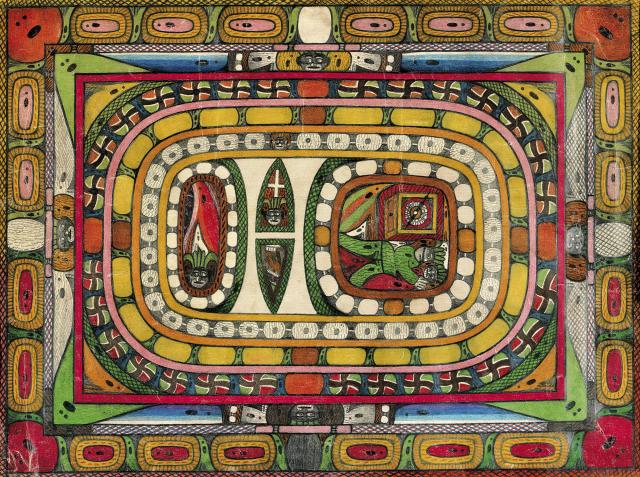In all of his works, Adolf Wölfli mixes autobiographical references and invented narratives relating an imaginary odyssey. The composition of this drawing possesses, as always, a hieratic, frontal character. Because Wölfli customarily drew from the periphery to the centre, an overall movement takes shape as a street or occasionally a railroad line, and draws along the entire composition in infinitely repeated twists and turns. These curves are articulated by rounded frames that are themselves reiterated inside the composition, from the margins to its centre.
Wölfli claimed he was the interpreter of a divine will and therefore didn’t especially look to clarify his drawings with precise explanations. The decorative elements have both an ornamental and a rhythmic function. When human figures are represented, most of the time they are depicted full face but with eyes looking sideways and outlined in black. The head rarely follows the eyes, which imparts a disturbing, at times authoritative expression to the face, suggesting perhaps the face of a prisoner or sentry.
In his way of working, Wölfli plans nothing; he thinks with his pencil. Often it is the gesture that sparks the thought in him. When one sheet of paper was filled, he would immediately move on to the next, without breaking the thread of his invention, as if it were indeed pages of continuous writing being produced.
On the reverse: text written in pencil, signed St Adolf II
Wölfli claimed he was the interpreter of a divine will and therefore didn’t especially look to clarify his drawings with precise explanations. The decorative elements have both an ornamental and a rhythmic function. When human figures are represented, most of the time they are depicted full face but with eyes looking sideways and outlined in black. The head rarely follows the eyes, which imparts a disturbing, at times authoritative expression to the face, suggesting perhaps the face of a prisoner or sentry.
In his way of working, Wölfli plans nothing; he thinks with his pencil. Often it is the gesture that sparks the thought in him. When one sheet of paper was filled, he would immediately move on to the next, without breaking the thread of his invention, as if it were indeed pages of continuous writing being produced.
On the reverse: text written in pencil, signed St Adolf II
